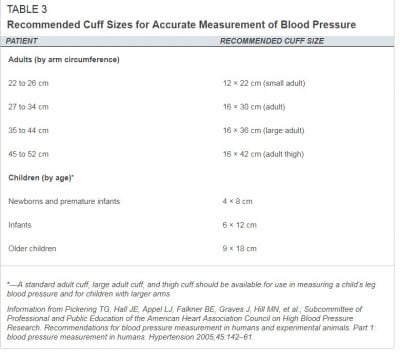Nelson Vergel
Founder, ExcelMale.com
The most common error in blood pressure measurement is use of inappropriate cuff size. Considerable overestimation can occur if the cuff is too small. The bladder length recommended by the AHA is 80 percent of the patient’s arm circumference, and the ideal width is at least 40 percent. Error is minimized when the cuff width is 46 percent of the arm circumference, although for large adult and thigh cuffs this is not practical. In obese patients, longer, wider cuffs are needed to compress the brachial artery adequately. In children, cuff bladder width should be at least 40 percent of the arm circumference halfway between the olecranon and acromion; the cuff should then cover 80 percent or more of the arm circumference. Recommended cuff sizes are listed in Table 3.

For correct cuff placement, the midline of the cuff bladder should be positioned over the arterial pulsation in the patient’s upper arm following palpation of the brachial artery in the antecubital fossa. There should be a 2– to 3–cm space for the stethoscope between the lower end of the cuff and the antecubital fossa, unless this would require an undersized cuff. In patients with an arm circumference greater than 50 cm, the cuff should be wrapped around the forearm, supported at heart level, and the radial pulse felt at the wrist http://www.aafp.org/afp/2005/1001/p1391.html

For correct cuff placement, the midline of the cuff bladder should be positioned over the arterial pulsation in the patient’s upper arm following palpation of the brachial artery in the antecubital fossa. There should be a 2– to 3–cm space for the stethoscope between the lower end of the cuff and the antecubital fossa, unless this would require an undersized cuff. In patients with an arm circumference greater than 50 cm, the cuff should be wrapped around the forearm, supported at heart level, and the radial pulse felt at the wrist http://www.aafp.org/afp/2005/1001/p1391.html


















